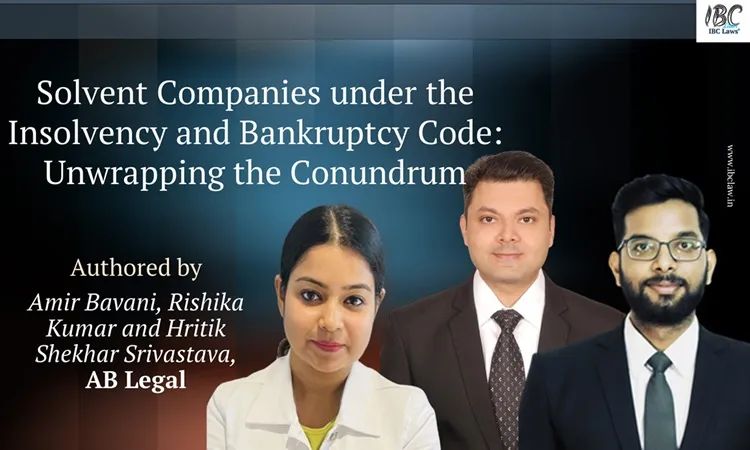Authored by: Amir Bavani, Founder, AB Legal Rishika Kumar, Senior Associate, AB Legal Anirban Aly Mandal, Associate, AB Legal
Introduction
With the advent of the Insolvency and Bankruptcy Code, 2016 (‘Code/IBC’), the framework for resolution of stressed assets and corporate entities was transformed into a streamlined, risk-friendly and timebound endeavor. The ecosystem of commerce in India has thrived since as rishconfidence amongst lenders, suppliers and investors to support the entrepreneurial spirit has strengthened. That being said, at the heart of the Code, “dispute” resolution is still an impediment to the implementation of the inherent ethos of the Code – value maximization of the assets of the Corporate Debtor and speedy resolution of the stressed entity. Even though the IBC prescribes for a time limit of one-hundred and eighty (180) days for completion of the Corporate Insolvency Resolution Process (‘CIRP’), with a mandate for a one-time extension of ninety (90) days, these timelines, as ensconced under Section 12 of the Code read with Regulation 40 of the Insolvency and Bankruptcy Board of India (Insolvency Resolution Process for Corporate Persons) Regulations, 2016 (‘CIRP Regulations’) have been held to be not mandatory in nature[1]. Naturally, the eventual resolution of a Corporate Debtor still remains to be a long-drawn out process marred by protracted litigation between the stakeholders of the Corporate Debtor. According to an Economic Times report[2], “Resolution timelines continued to increase for OCs [Operational Creditors] and FCs [Financial Creditors], with the highest being 635 and 643 days for OCs and FCs, respectively,” as of August, 2023.
The biggest contributor to this factum of delay can be identified as the wide array of disputes that are brought before the Hon’ble National Company Law Tribunal (‘NCLT’) vis-à-vis the conduct of the CIRP, by the Corporate Debtor’s stakeholders as well as any remote party under Section 60(5) of the Code. This is where mediation as a dispute resolution tool presents itself before the Code as a worthy inductee to aid and transform the incumbent insolvency regime and preach the gospel of non-adversarial, amicable dispute resolution so as to foster efficient and robust outcomes in insolvency cases. This article shall endeavor to chart the (i) advent of mediation as a Dispute Resolution Mechanism in India, (ii) the framework of mediation under the Code as suggested by the Expert Committee, and (iii) dissect the framework as considered and discussed under the Report[3] in light of the groundbreaking Mediation Act, 2023.
Evolution of mediation in India and the Mediation Act, 2023
Mediation as a process is designed to facilitate communication and negotiation between parties to assist them in reaching a voluntary “win-win” resolution to their conflicts. The Dispute Resolution landscape in India is also no stranger to mediation as a tool for amicable, collaborative resolution of conflicts. For instance, even prior to the British Rule in India, commercial disputes between merchants, traders and the likes were settled through a form of mediation headed by the Mahajans, who were known to be prudent, impartial and respected businessmen. Back in those days, commercial disputes were de facto referred to mediation. If a merchant did initiate proceedings in a Court of law before referring the dispute to mediation, then, the merchant would be sanctioned by dismemberment from the Association[4].
In the more modern context, legislative recognition was first afforded to mediation under the Industrial Disputes Act, 1947, wherein a comprehensive framework for mediation proceedings were provided for. For instance, the conciliators appointed under Section 4 of the Act are “charged with the duty of mediating in and promoting the settlement of industrial disputes”. The Arbitration and Conciliation Act, 1996 was a watershed moment for Alternate Dispute Resolution mechanisms (‘ADR’) in India. However, mediation of disputes was not included in this legislative package. Thereafter, in 1999, the Indian Parliament passed the Code of Civil Procedure Amendment Act of 1999 inserting Section 89 in the Code of Civil Procedure, 1908 (‘CPC’) providing for reference of cases pending in the courts to ADR, which for the first time included mediation. The contours of mediation as an ADR mechanism were strengthened for commercial disputes with the amendment of the Commercial Courts Act, 2015, whereby, Section 12-A was introduced. In essence, Section 12-A of the Act mandates pre-litigation mediation. Therefore, a suit cannot be filed under the Act without the parties first attempting to resolves their disputes vide mediation. The only exception to this rule being the prayer of any party for an urgent interim relief in the matter.
In more recent times, mediation has been afforded recognition as a premier dispute resolution mechanism, and the importance of amicable settlement of conflicts outside the purview of Courts has also been taken cognizance of by the legislature. Hence, On September 15, 2023, the Central Government notified the Mediation Act, 2023[5] (‘Act’). Thereafter, on October 9, 2023, the Ministry of Law and Justice notified that certain provisions of the Mediation Act, 2023 have come into force – these provisions included; provisions relating to the Mediation Council of India, the Mediation Fund, power of the Central Government to issue directions, power to make rules and regulations, amongst others.
Before we delve into the framework for mediation as envisaged and discussed by the Expert Committee in its report, it is appropriate to first extract the salient features of the Act as the fate of the two apropos mediation under the Code are interwoven. The most novel conception under the Act is the introduction of Mediated Settlement Agreements (‘MSA’). An MSA essentially is an agreement between the parties recording the terms of settlement in pursuance of resolution of some or all of the disputes between such parties, and authenticated by the mediator[6]. Under the aegis of the Act, as per Section 20, such MSAs can also be registered giving the proceedings under the Act, and the final outcome further credence. Additionally, the Act envisages the mediation process under the Act to be a timebound process with a period of one-hundred and twenty (120) days from the first appearance before the mediator fixed as the timeline for completion of the mediation proceedings. The period of mediation may be extended for a further period as agreed by the parties, but not exceeding sixty (60) days[7]. Furthermore, the Act also provides for strict standards of confidentiality and provisions for future implementation of online mediation under Section 22 and Chapter VII of the Act, respectively.
Read the full article HERE.





